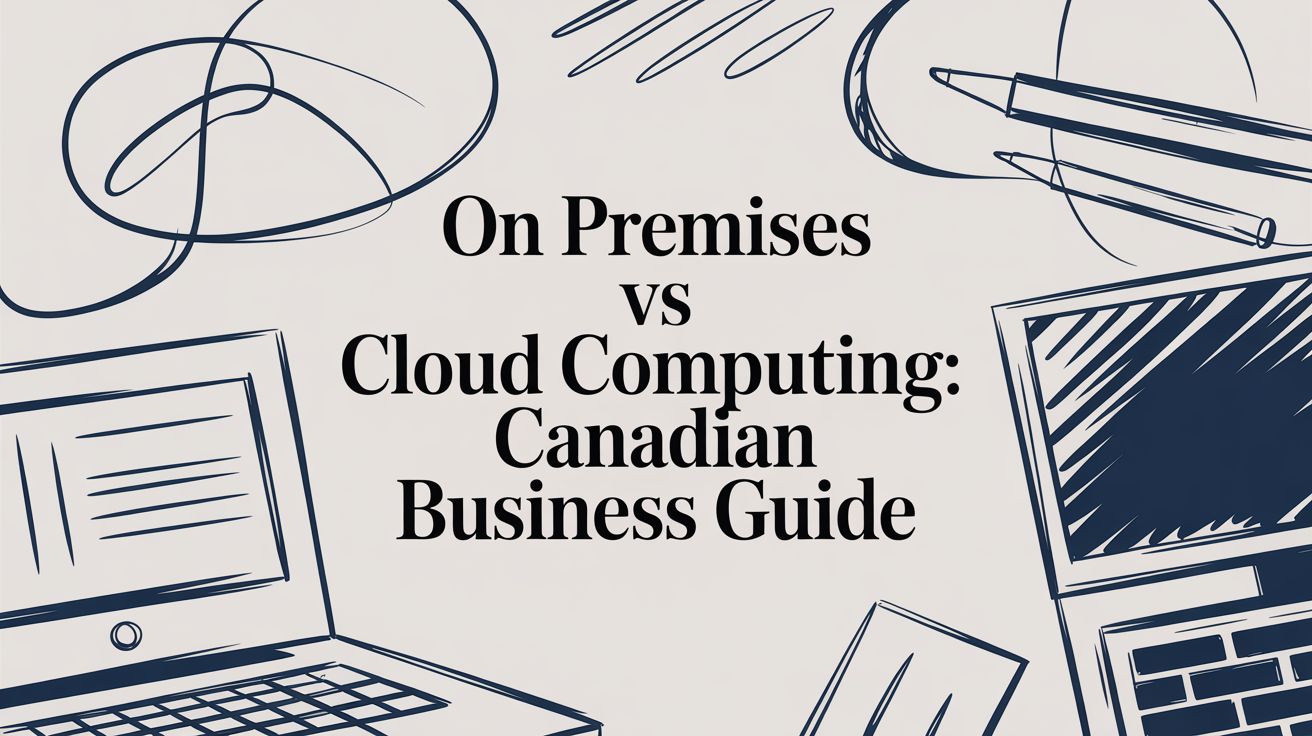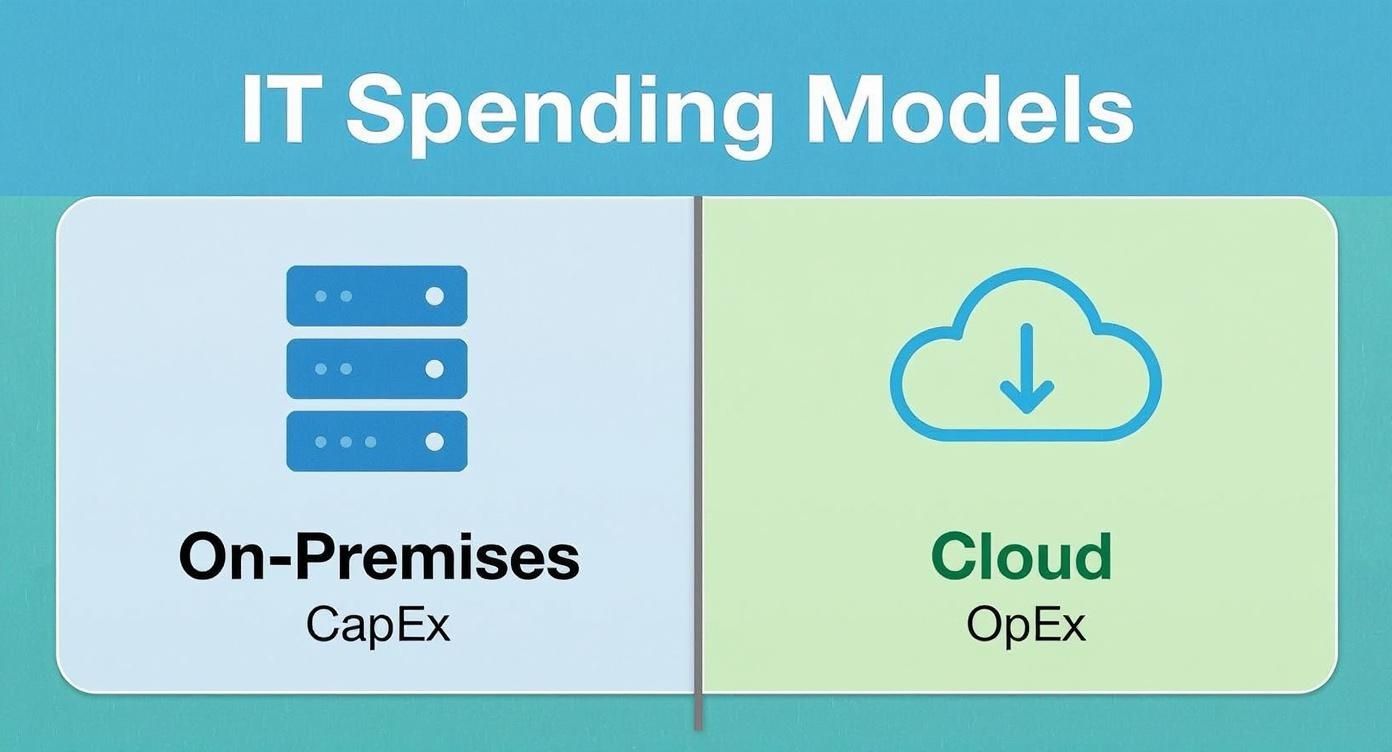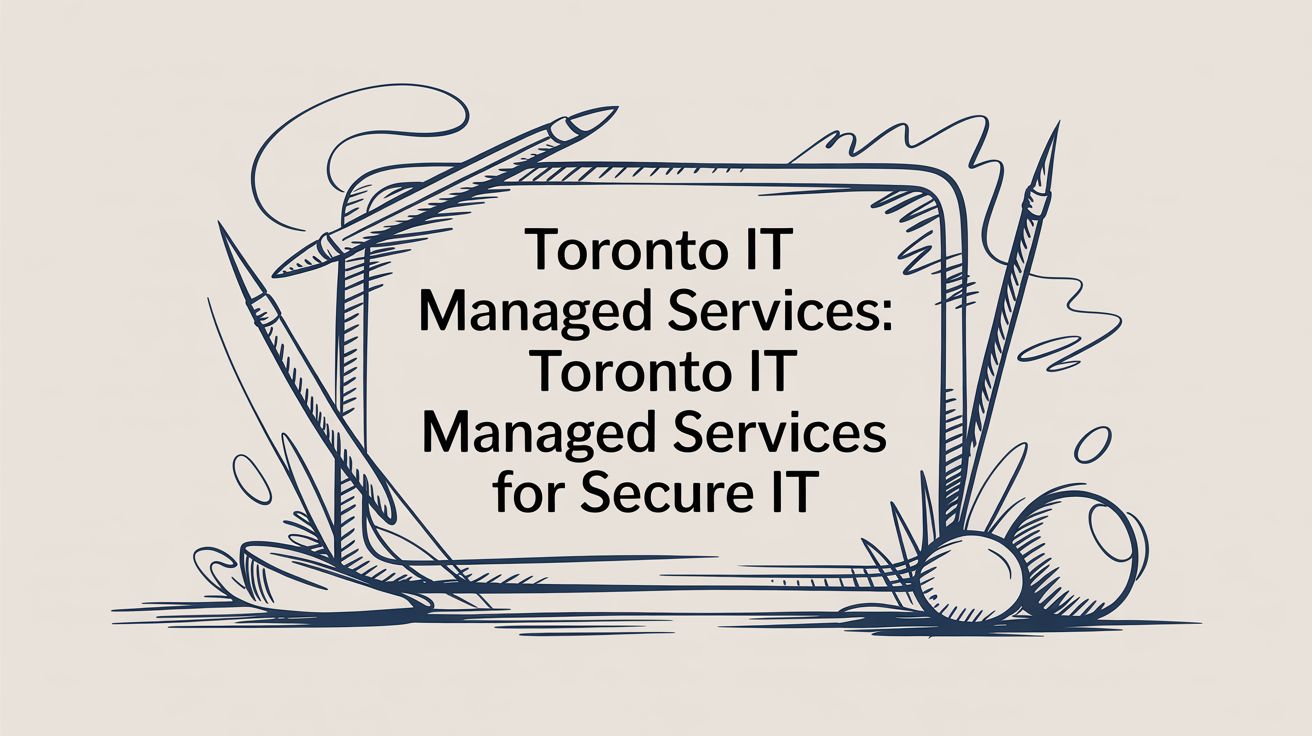
December 26, 2025
What Is Privileged Access Management? A Guide for Canadian BusinessesDiscover what is privileged access management, how PAM protects critical assets, and why it's essential for safeguarding your organization.
Read Full Post%20(1).webp)
Usman Malik
Chief Executive Officer
November 11, 2025

The core difference between on-premises vs cloud computing boils down to ownership and location. With an on-premises setup, your organization buys, owns, and manages its own servers in your own facility. The cloud, on the other hand, means you are renting computing power from a provider over the internet.
Your choice hinges on what your organization values more: the direct control and significant upfront capital investment of an on-premises model, or the flexibility, scalability, and operational expense model of the cloud.
Choosing between on-premises and cloud computing is one of the most critical infrastructure decisions any Canadian business will make. There is no single right answer; the decision comes down to your specific needs for security, cost predictability, scalability, and—especially in Canada—regulatory compliance. This decision forms the bedrock of your operations, influencing everything from how you budget to your IT team's daily workload.
Before you dive deep into the technical details, it's worth understanding the broader landscape of critical IT decisions for small businesses, since infrastructure is just one piece of a larger strategic puzzle.
This choice becomes even more pointed for businesses in compliance-heavy sectors like Canadian healthcare, finance, or manufacturing. Regulations such as the Personal Information Protection and Electronic Documents Act (PIPEDA) demand a careful examination of where your data resides and how it is secured.
To kick things off, let's get a clear, high-level view of both models.

This table provides a high-level summary of the essential differences between on-premises infrastructure and cloud computing. It is designed to help you quickly grasp the core distinctions of each model at a glance.
As you can see, the differences are stark, touching every aspect of IT management.
The most significant shift is financial. On-premises is a long-term capital investment, much like buying a building, whereas the cloud is an operational expense, similar to leasing office space. This distinction fundamentally changes how you budget for and manage your IT.
This guide will break down these factors in more detail, providing a solid framework to determine which approach truly fits your organization’s unique needs and long-term goals.
To make the right decision in the on-premises vs. cloud computing debate, you first need to grasp their fundamental differences in operation and finance. These are not just minor technical details; they represent two completely different philosophies for managing your company’s digital backbone. Your choice will directly shape your budget, your IT team's day-to-day work, and the level of control you have over your most critical business assets.
At its heart, an on-premises model is about ownership. You buy, run, and maintain all your IT hardware and software licences right there in your own physical space. This is a classic Capital Expenditure (CapEx) model, meaning it requires a significant upfront investment in servers, storage, and networking equipment.
Cloud computing, however, operates more like a rental service. You lease computing resources—from storage to raw processing power—from a third-party provider like Amazon Web Services (AWS) or Microsoft Azure. This completely flips the financial model, moving your IT costs to an Operational Expenditure (OpEx) model. You pay a recurring fee for what you use, much like a utility bill.
With on-premises infrastructure, you have complete and total control. Your IT team is hands-on with every single aspect of the environment, from the physical security of the server room to the configuration of the last software patch. This level of direct control is often non-negotiable for organizations with unique security protocols or highly specialized operational needs.
That control, however, comes with the full weight of responsibility. Your team is accountable for everything: maintenance, troubleshooting, security updates, and managing the lifecycle of all hardware. Digging into the various IT infrastructure components can provide a much clearer picture of everything this involves.
Cloud computing, in contrast, operates on a shared responsibility model. The cloud provider takes care of the physical hardware, networking, and core infrastructure, which frees your team from the grind of daily upkeep. This allows them to focus on more strategic projects, but it also means you are handing over direct control of the underlying hardware.
The decision between owning and renting your infrastructure is the true crux of the on-premises vs. cloud computing comparison. Owning gives you unparalleled control but demands constant investment in maintenance and expertise. Renting offers incredible flexibility and managed services, but at the cost of that direct oversight.
For many Canadian businesses, the financial models are the biggest differentiator. An on-premises setup demands a large, planned capital outlay. This can be beneficial for businesses that prefer predictable, fixed costs and have the capital ready to invest.
In contrast, the cloud’s pay-as-you-go OpEx model offers financial flexibility and completely removes the need for massive upfront purchases. This approach is especially attractive for startups and growing businesses that need to conserve capital and scale their resources up or down as needed.
The shift toward this flexible spending model has been dramatic. The widespread adoption of cloud infrastructure has reshaped IT spending entirely. In fact, McKinsey projected that most enterprises planned to allocate 80% of their IT hosting budgets to cloud services by 2024. This trend highlights a massive transformation in how businesses approach technology strategy. This move from CapEx to OpEx is not just a line item on a budget; it is a strategic pivot that changes how businesses plan for the future.
When you are trying to decide between on-premises infrastructure and cloud computing, it is time to move past generic pro-and-con lists. You need a deeper analysis that shows how each model performs under the real-world pressures of your business, especially if you are a Canadian small or medium-sized enterprise (SME). The right choice hinges on a careful look at cost, security, compliance, and performance.
The financial side of the on-premises vs. cloud debate goes far beyond the initial price tag. On-premises requires a significant upfront Capital Expenditure (CapEx) for hardware, while the cloud runs on a pay-as-you-go Operational Expenditure (OpEx) model. This is a fundamental difference in spending that every business leader needs to understand.
This infographic paints a clear picture of the core financial models.

It really boils down to this: are you investing capital upfront, or are you paying recurring operational fees?
But a true Total Cost of Ownership (TCO) analysis must dig into the hidden expenses tied to each option.
The bottom line is that while cloud computing offers a lower barrier to entry, on-premises systems can actually be more cost-effective over the long haul for businesses with stable, predictable workloads.
For any Canadian business, especially those in regulated industries like healthcare or finance, security and compliance are absolutely non-negotiable. This is where the debate over data control and protection truly heats up.
An on-premises setup provides the ultimate level of control. Your data lives within your four walls, managed by your own team, under your direct security rules. This can be a significant advantage for organizations handling extremely sensitive information or needing to meet specific compliance standards that large cloud providers do not cover out of the box.
However, complete control also means complete responsibility. Your team is solely accountable for everything—from firewalls and intrusion detection to patch management.
In contrast, major cloud providers like Microsoft Azure and AWS invest billions in their security infrastructure and teams, offering a level of protection most SMEs could never dream of building themselves. Their platforms are designed to meet tough global and national standards, including Canada's own PIPEDA (Personal Information Protection and Electronic Documents Act).
When you are weighing these options, you have to think about project management. Planning and executing the setup and ongoing maintenance requires very different skill sets for each model. You can learn more by exploring resources on Mastering IT Infrastructure Project Management Strategies.
A major factor for Canadian businesses is data sovereignty—making sure your data stays within Canada's borders. The good news is that leading cloud providers now have dedicated Canadian data centre regions, so you can meet this requirement while still getting their enterprise-grade security. This directly tackles one of the biggest historical arguments against moving to the public cloud.
How well your infrastructure can adapt to your business's changing needs is crucial for growth. This is where the differences between on-premises and cloud are most dramatic.
On-premises infrastructure provides stable, predictable performance from hardware that is entirely yours. For applications that have consistent, heavy workloads, this can be the perfect setup. The resources are dedicated to you, so you do not have to worry about the "noisy neighbour" effect that can sometimes appear in shared cloud environments.
The major downside is its rigidity. Scaling up an on-premises system is a slow, expensive process. It involves:
This entire process can take weeks, if not months. It makes it impossible to react quickly to a sudden opportunity or an unexpected spike in demand.
The cloud, on the other hand, offers almost instant elasticity. You can spin up new servers or add more processing power and storage with just a few clicks. This on-demand scalability is a game-changer for businesses with fluctuating workloads, like a manufacturing firm with seasonal demand or a retailer preparing for Black Friday. You can explore more on the benefits of cloud computing services in our detailed guide.
This agility allows businesses to innovate faster, test new ideas without a massive capital investment, and pay only for the resources they are actually using.
Theory is one thing, but how does the on-premises vs. cloud computing debate play out in the real world? To truly understand this, we need to look at specific examples that reflect the day-to-day realities of Canadian businesses. Every company faces its own unique set of pressures, whether navigating complex regulations or dealing with market volatility, and those factors will always shape the right IT decision.
Let's walk through three distinct scenarios to see how these infrastructure models hold up under pressure. For each one, we will recommend the best fit—on-premises, cloud, or a mix of both—and break down why it makes the most sense.

Picture a bustling healthcare clinic in the heart of Toronto. It handles thousands of electronic health records (EHRs) packed with sensitive patient data. For this clinic, the top priorities are rock-solid security and bulletproof compliance with Canada's Personal Information Protection and Electronic Documents Act (PIPEDA). Its systems must be available 24/7 for patient care—downtime is simply not an option.
The clinic must guarantee data residency, meaning every piece of patient information must remain within Canadian borders. It also needs constant uptime so physicians can access records anytime, whether they are in the clinic, at a hospital, or conducting a remote consultation. While budget matters, it is a distant second to security and reliability.
Recommendation: A Hybrid Cloud Approach
A hybrid model is the ideal solution for this healthcare scenario. It offers the perfect balance of control and flexibility.
This strategy truly delivers the best of both worlds, pairing absolute control over patient data with the modern services and agility of the cloud.
Now, let's consider an established financial advisory firm in Calgary that manages portfolios for high-net-worth clients. Its entire business is built on a foundation of trust and strict confidentiality. Its proprietary trading algorithms and clients' financial data are the crown jewels, and the number one priority is to protect them from any possible breach.
The firm’s workload is very predictable; it does not see massive, unexpected traffic spikes. It also has a strong preference for a predictable, fixed-cost model (CapEx) over the fluctuating monthly bills (OpEx) that come with the cloud. For this firm, having total control over its hardware and software is a non-negotiable part of its security strategy.
Recommendation: A Pure On-Premises Solution
For this Calgary firm, a traditional on-premises setup is the most logical and secure path forward. The reasoning is clear: control and security trump the potential benefits of cloud scalability.
When your entire business model rests on the absolute security of proprietary data and predictable performance, owning your infrastructure is not a cost—it is a strategic investment in risk management.
By keeping all their servers, storage, and networking gear in-house, the firm maintains complete command over its security protocols. They can implement custom security measures that might be difficult or impossible in a shared public cloud environment and can guarantee that no third party ever has physical access to their hardware. With stable workloads, the upfront capital investment in powerful, reliable equipment provides a predictable Total Cost of Ownership over a five-to-seven-year lifespan.
Finally, consider a manufacturing company in Quebec that produces seasonal products. Demand for their goods skyrockets in the months before the winter holidays but drops off significantly during the summer. Their supply chain management (SCM) and enterprise resource planning (ERP) systems need to handle enormous loads during peak season but would sit nearly idle for half the year.
This company needs an infrastructure that is both powerful and incredibly flexible. Paying for massive server capacity that goes unused for six months is a huge waste of money. Their priority is elasticity—the ability to spin up resources to meet intense demand and then scale them right back down to save costs during the slow months.
Recommendation: An All-Cloud Infrastructure
This manufacturing company is a textbook case for moving entirely to the public cloud.
The cloud’s defining feature—on-demand scalability—is the direct answer to their biggest business challenge. During their off-season, they can run their SCM and ERP systems on a bare-bones set of cloud resources, keeping costs at a minimum. As orders start pouring in, they can automatically scale up their computing power and storage in a matter of minutes, not months.
This pay-as-you-go model shifts their IT costs from a fixed capital expense to a variable operational expense that perfectly mirrors their revenue cycle. This kind of agility is a massive competitive advantage, letting them react to market changes almost instantly without being held back by the limits of physical hardware.
The conversation around on-premises vs. cloud computing often feels like a choice between two extremes. But it does not have to be an all-or-nothing decision. For many Canadian businesses, the smartest move is not choosing one over the other but blending them into a hybrid cloud model. This approach provides the best of both worlds: the solid security and control of your own private infrastructure combined with the sheer power and flexibility of the public cloud.
A hybrid strategy lets you keep your most sensitive data locked down on-premises while using the public cloud’s massive resources for everything else. The result is a balanced, flexible, and often more cost-effective IT environment that is perfectly aligned with your business goals. It is a practical solution that recognizes not all data and applications are created equal.

One of the biggest drivers for a hybrid model is the need to balance tight security requirements with the demand for business agility. For instance, a company can keep its crown jewels—like core intellectual property or a customer database—on a private, on-premises server. This provides maximum control and makes it much simpler to stay compliant with regulations like PIPEDA.
At the same time, that same company can tap into the public cloud for less sensitive but more resource-hungry tasks. Some of the most common ways businesses use the public cloud side of a hybrid strategy include:
This tiered approach is a smart way to manage risk. You isolate your critical assets while still getting all the benefits of modern cloud capabilities.
A well-designed hybrid cloud is not a temporary compromise; it is a deliberate business strategy. It allows you to place each workload in the most optimal environment based on its specific requirements for security, performance, and cost.
While a hybrid setup offers incredible flexibility, it also brings its own set of challenges. Managing two different environments—and making them communicate effectively—requires careful planning and the right expertise to ensure everything works together seamlessly.
Integration can be a major hurdle. Getting data to flow smoothly and ensuring applications perform consistently between your on-premises systems and the public cloud demands robust networking and sophisticated management tools. Likewise, you must maintain consistent security protocols across both platforms to avoid accidentally creating new vulnerabilities where they connect. It is these complexities that often lead businesses to seek professional cloud migration services for a smooth transition.
For many medium-sized organizations, the operational headache of managing a hybrid environment can be overwhelming. This is where partnering with a managed IT services provider becomes a practical solution. The right experts can handle the complex tasks—the integration, monitoring, and security of your entire hybrid setup—freeing you to focus on your actual business.
Choosing between on-premises and cloud computing is a major decision that will define how your business operates for years to come. This is not about jumping on the latest technology trend; it is about a thorough analysis of your specific business needs. Getting this right requires a clear framework to ensure your choice aligns with your long-term goals.
The entire process must start with introspection. Before you can even begin to evaluate platforms, you need to understand your own company's operational DNA. That means digging into your workloads, budget structure, compliance obligations, and the IT skills you already have on your team.
To get a clear picture of what you truly need, start by asking some direct questions. This checklist will help you pin down your requirements and see which infrastructure model is the natural fit for your business.
The right infrastructure choice is one that supports your business objectives, not one that forces your business to conform to its limitations. A thorough internal audit using these questions provides the data needed for a truly strategic decision.
Once you have a clear direction, the focus shifts to execution. Whether you are upgrading an on-premises setup or planning a move to the cloud, a phased, strategic approach is critical to minimize disruption. Rushing the process without a solid plan can lead to expensive downtime and operational chaos.
This is where partnering with a managed IT expert like CloudOrbis can make all the difference. A comprehensive assessment can validate your internal findings and help build a detailed roadmap for implementation. This ensures your new infrastructure is not just a technical upgrade, but a powerful tool to move your business forward.
When weighing on-premises against the cloud, Canadian business leaders always have a few key questions. Getting clear, practical answers is the only way to make a sound decision that aligns with your budget, compliance needs, and day-to-day operations. Here are some of the most common queries we receive.
This is a top concern, and rightly so, especially for anyone in an industry governed by PIPEDA. The short answer is yes, but only if you choose the right cloud provider and configure it correctly.
Leading providers like AWS and Microsoft Azure have dedicated Canadian data centre regions. This is crucial because it ensures your data never physically leaves the country, which is a cornerstone of data sovereignty.
Furthermore, these companies invest billions in security measures that most businesses could never afford. They provide powerful tools for advanced encryption, identity management, and threat detection, along with certifications that meet tough Canadian and international compliance standards. The catch is that you must uphold your end of the "shared responsibility model" by managing access controls and configurations properly.
While the cloud's pay-as-you-go model sounds appealing, unexpected bills can arise if you are not monitoring usage closely. One of the biggest culprits is data egress fees—the charges for moving data out of the cloud. If your business regularly transfers large files or datasets, these costs can accumulate quickly.
Other surprise expenses can include:
There is no single answer. The timeline depends entirely on the complexity of your current IT setup, the amount of data you are moving, and how well you plan.
A simple project, like moving a single, standalone application, might only take a few weeks. However, a full-scale migration of interconnected systems could take several months or even over a year. A thorough assessment and a phased approach are absolutely critical for setting realistic expectations and minimizing business disruption.
Navigating the choice between on-premises and cloud solutions requires real-world expertise. CloudOrbis Inc. provides strategic IT consulting to help you assess your needs, plan your infrastructure, and execute a seamless transition. We ensure your technology aligns perfectly with your business goals.
Find out how we can help at https://cloudorbis.com.

December 26, 2025
What Is Privileged Access Management? A Guide for Canadian BusinessesDiscover what is privileged access management, how PAM protects critical assets, and why it's essential for safeguarding your organization.
Read Full Post
December 25, 2025
A Business Leader's Guide to Toronto IT Managed Servicestoronto it managed services can secure data, streamline IT, and boost growth - discover the right partner today.
Read Full Post
December 24, 2025
Moodle LMS for Alberta Private Career Colleges: A Guide to Boosting Compliance and OutcomesDiscover how moodle lms for alberta private career colleges can streamline compliance, boost efficiency, and improve student outcomes.
Read Full Post